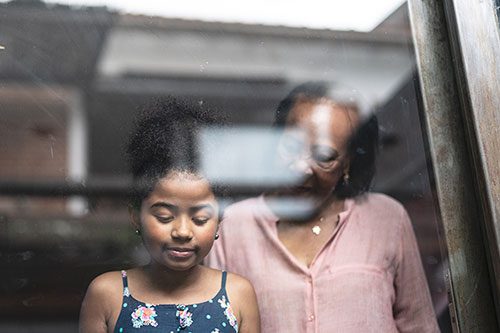 If you’re in an unexpected pregnancy and considering adoption, you may have thought about placing your child with a member of your family or with extended family members.
If you’re in an unexpected pregnancy and considering adoption, you may have thought about placing your child with a member of your family or with extended family members.
Kinship adoption, or relative adoption, as it’s sometimes called, works for some birth mothers, but it isn’t right for everyone. Because every family dynamic is unique, it’s important to consider both the advantages and disadvantages for you and your child before choosing a kinship adoption. While a kinship adoption may work for some, it often causes conflict and blurred lines.
What is Kinship Adoption?
Kinship adoption is when an adult family member who is eligible and willing becomes a child’s legal parent through adoption. The birth mother usually stays active with the kinship caregivers and her child as they grow up.
When a child can’t safely remain in their parents’ home or be reunited with them, placement with relatives is typically the first choice considered by foster care workers in social services. In some cases, if a baby is born with substance exposure, Child Protective Services may seek to place them with a relative.
Families formed through a kinship adoption often face specific challenges that are different from families formed through other adoptions.
Advantages and Disadvantages of Kinship Adoption
Kinship adoption can be a great solution, but it can also come with its own set of challenges. For example, your relative may feel they are just helping out for a time, or there may be some issues with interaction and boundaries that will need to be worked through. Here are a few advantages and disadvantages to kinship adoption to consider.
Trust and familiarity
If you have a good personal relationship with the relative that your baby will be raised with, trust has already been established. That means you will likely have fewer concerns about the life that your baby will have with them. Kinship adoption, in which one family member places their child with another family member ready to take on the role of parent, can allow for trust and familiarity from the outset.
Different feelings of loss
Post-adoption, all birth mothers will experience feelings of grief and loss. Giving your baby to a family member to raise may provide greater peace because you already know the person well.
Easier ongoing contact
Having a relative adopt your baby after delivery may mean that you get more opportunities to see and interact with your child. You could have the potential for more in-person visits, holiday gatherings, phone calls, and more.
There are definitely pros and cons of building a relationship after you’ve placed a child for adoption. Do keep in mind that as a birth parent, you have legal parental rights. Adoption agencies such as Lifetime Adoption can put you in touch with adoption attorneys and others who can help you make the right decision for you.
Confusion
As your child grows up and begins to form connections with people, there may be some confusion on roles. For example, if you choose to give your baby to your parents to raise, the child will be yours biologically, but it would be a brother or sister in the legal sense. Unless you and your family work hard to establish and maintain roles from the very get-go, it could be confusing for your child and everyone involved.
Boundaries
Be sure to set clear boundaries during the adoption process. You may need to enlist the help of an adoption agency or social worker to help iron out the details of visitation and boundaries.
Even with clearly defined boundaries, some challenges will come up. Kinship adoptions can be some of the most challenging options because of the established relationships. Your relatives may want more separation from you, but you might want more contact. Clearly established boundaries are vital for kinship adoption success.
Family dynamics will change
When you are considering letting a family member adopt your baby, ask yourself if you are ready for what that arrangement will look like. It will forever impact your family dynamic. Will it influence it in a positive and healthy way? Or will it make it difficult? You may disagree with how they parent your child. They may worry you will change your mind about the adoption.
It is important to really think about what your kinship adoption will look like, not just immediately but well into the future as your child gets older and more independent. Think about future holidays, gatherings, and other family events — there will be awkward times.
The old saying, “It’s easier to deal with a stranger than a relative,” may be true. Family can be complicated, so consider this if you’re thinking about a kinship adoption.
What Does the Kinship Adoption Process Look Like?
The first step for any extended family members who wish to pursue the kinship adoption process is to, along with the biological parents, if possible, reach out to a family law attorney and ask what the adoption process looks like.
If social services is already involved in the situation (for instance, a child who was placed through foster care), the kinship adoption process may be different, and there may be financial assistance for adopting the child.
Each state has its own laws for kinship adoptions, and every situation may look different. For example, in some states, if a child lives in the home of the kinship caregivers for three or more years, then no home study may be required, and the birth mother can sign the adoption consent forms and petition for adoption outside of court. Similarly, some states may require a home study of the kinship caregivers if the child has been in the home less than three years and allow the biological parent to sign a consent to be filed in a juvenile court. These are all individual and unique family law guidelines that may even be interpreted differently in various jurisdictions within the states. It seems confusing, but that is the nature of adoption laws that are state-specific.
If a home study is required, a social worker from an adoption agency like Lifetime Adoption will come visit your home, conduct background checks, and provide education to you to help with the process. If the child is currently in the foster care system, this may be conducted by a social worker from social services. In either case, it is an excellent opportunity for the extended family members who will be adopting the child to seek local resources, ask advice for possible needs (like counseling or future contact with the birth parents), and much more. It is important to note that if a home study is required, there may be follow-up visits post-adoption too.
Consider Your Adoption Options
It’s important to think about whether kinship adoption is right for you and your child. Consider both the advantages and disadvantages of a kinship adoption process. In some ways, this type of adoption is easier for you, but it could have its challenges, too. You know your family dynamic and how your family works. As you consider whether you should take this step, think about how your family functions regarding:
- Communication
Is there the ability to speak honestly about issues? Would you be comfortable bringing up your thoughts or asking questions? - Handling disagreements
Does your family talk through their disagreements, or do they give one another the silent treatment? - Money
Does your family often argue about money? Will your relatives expect your financial assistance even if they’re adopting your child? Money divides many families, so it’s worth thinking about how your family thinks about it.
How Lifetime Adoption Can Help With Your Adoption Options
Choosing adoption is a brave and selfless decision. If you’ve decided that you want to move forward with the open adoption process with a family outside of your home, our experienced team at Lifetime Adoption can help.
If you’ve asked yourself, “Should I think about giving my baby up for adoption to a family member?” you can call and speak with one of our adoption coordinators anytime. She can help you sort through the potential challenges. In addition, as you work with an expert and experienced adoption coordinator, you will get your other questions answered and any concerns resolved.
We work with birth mothers of all kinds each and every day, and we understand that you want what is best for both you and your baby. To speak with a caring adoption coordinator, contact us today.
Editor’s Note: This article was originally published on October 16, 2020, and has since been updated.
As Vice President of Lifetime Adoption, Heather Featherston holds an MBA and is passionate about working with those facing adoption, pregnancy, and parenting issues. Heather has conducted training for birth parent advocates, spoken to professional groups, and has appeared on television and radio to discuss the multiple aspects of adoption. She has provided one-on-one support to women and hopeful adoptive parents working through adoption decisions.
Since 2002, she has been helping pregnant women and others in crisis to learn more about adoption. Heather also trains and speaks nationwide to pregnancy clinics to effectively meet the needs of women who want to explore adoption for their child. Today, she continues to address the concerns women have about adoption and supports the needs of women who choose adoption for their child.
As a published author of the book Called to Adoption, Featherston loves to see God’s hand at work every day as she helps children and families come together through adoption.






0 Comments